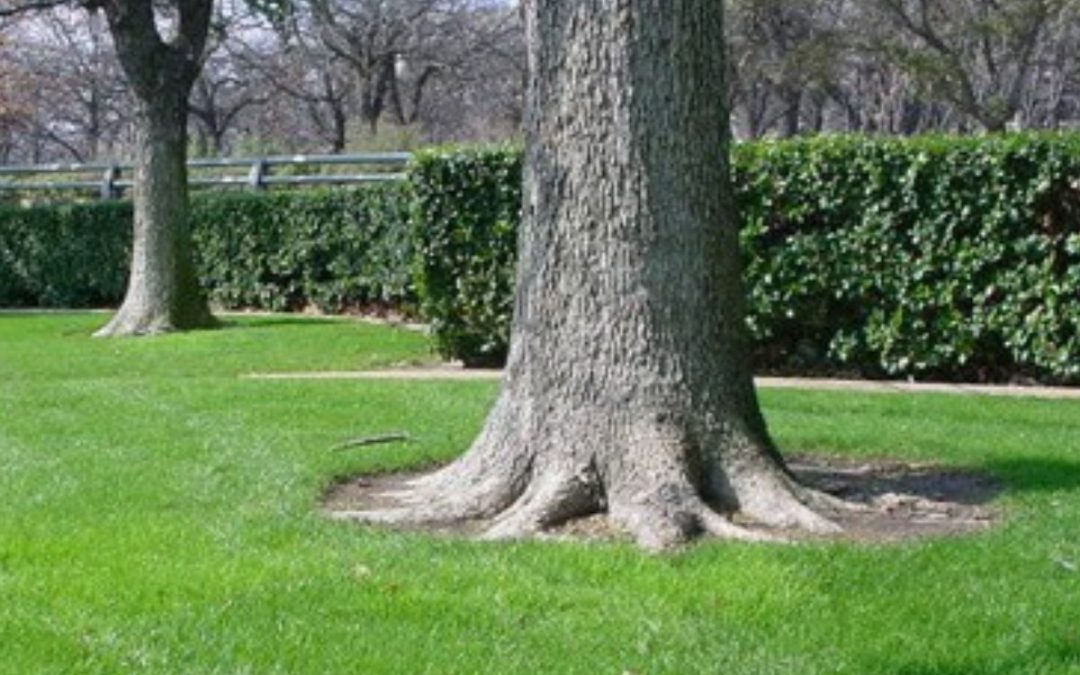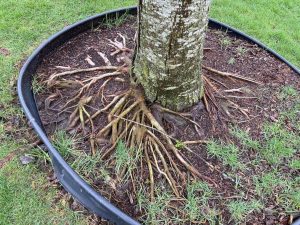Many tree species have flared roots at the base of the trunk. This flare is an important structural component of the tree and helps to anchor the tree in the soil and resist tipping over in strong winds. The root flare also helps to facilitate water and nutrient uptake by the tree’s roots. Unfortunately, many trees are planted too deeply, which can cover up the root flare and cause problems for the tree. In this blog post, we’ll discuss how to identify root flare on trees.
What is Root Flare?
The root flare is the portion of the trunk where the roots begin to branch out. When the roots are exposed (due to erosion, poor planting, or compaction), this area is more susceptible to damage and disease. The roots are also more likely to dry out, which can stress the tree and lead to problems.
What Causes Root Flare?
There are several reasons why root flare may occur:
-Erosion: Over time, soil can erode away, exposing the roots. This is most likely to happen in areas with high winds or heavy rains.
-Poor Planting: If a tree is not planted properly, the roots may not be able to grow properly. This can cause them to become exposed over time.
-Compaction: When the soil around a tree is compacted (usually by heavy equipment), it can put pressure on the roots and cause them to become exposed.
 How Can I Fix It?
How Can I Fix It?
If your tree has root flare, there are a few things you can do to fix it:
-Add Mulch: Adding mulch around the base of the tree will help protect the roots from erosion and compaction.
-Water Deeply: Watering deeply will help keep the roots moist and prevent them from drying out.
-Support the Roots: If you have exposed roots, you may need to support them with staking or other methods so they don’t break under their own weight.
How to Identify Root Flare on Trees
There are a few ways that you can identify root flare on trees. One way is to look at the trunk itself. The root flare should be visible as a bulge or swell just above where the roots begin to spread out. Another way to identify root flare is by looking at the tree’s leaves. If the leaves are yellowing or Drop more than normal, it could be a sign that the root flare is buried and the tree is not able to take up enough water and nutrients. Finally, you can try digging around the base of the tree to see if you can expose any of the roots near the trunk. If you can’t find any roots near the trunk, it’s likely that the root flare is buried.
The root flare is an important part of the tree’s anatomy. It helps to support the tree and provides a transition area between the roots and trunk. A tree with an exposed root flare is not only more susceptible to damage, but it can also be a sign of underlying problems. If you think your tree might need a root flare excavation, here are some things to look for.
The root flare is the point where the tree’s roots begin to flare out from the trunk of the tree. The easiest way to find root flare is to look for it at ground level. Look for a point where the trunk begins to widen out or where the roots begin to spread out. If you’re having trouble finding it, you can also try gently brushing away some of the soil around the base of the tree.
Once you’ve found root flare, it’s important to make sure that it’s not buried under too much soil. If it is, this can cause a number of problems for the tree including:
-The tree may not be able to get enough oxygen and may suffocate.
-The tree may not be able to get enough water and may dehydrate.
-The tree may be more susceptible to insect infestations and diseases.
-The tree may be more likely to fall over in high winds because its roots will not be properly anchored in the ground.
If you think that your tree’s root flare might be buried, there are a few things you can do:
-Gently excavate around the base of the tree until you find a root flare. Be careful not to damage the roots in the process.
-Once you’ve found root flare, rake away any mulch or debris that might be covering it up.
-If there’s still too much soil covering the root flare, you may need to lightly prune away some of the lower branches of the tree. This will help expose more root flare so that it can get the oxygen and water it needs.
Signs that a Tree Needs a Root Flare Excavation
The most obvious sign that a tree needs a root flare excavation is if the roots are visible at the base of the tree. This can happen for a number of reasons, including poor planting practices, erosion, or compaction of soil around the base of the tree. If you see roots poking out from the soil, it’s time to call in a professional.
Another sign that your tree might need a root flare excavation is if the tree is leaning. This can be caused by many factors, including pests, disease, or simply inadequate support from the roots. If you see your tree leaning, it’s best to call in a professional arborist to assess the situation and determine if a root flare excavation is necessary.
A third sign that your tree may need a root flare excavation is if the bark is peeling or cracking at the base of the trunk. This can be caused by many factors, including insects, weather damage, or disease. If you see this happening to your tree, it’s best to call in a professional arborist to assess the situation and determine if a root flare excavation is necessary.
Conclusion
Identifying root flares on trees is important for tree health. If you think that a tree may not have a visible root flare, there are a few things that you can do to check, including looking at the trunk for a bulge or swelling just above where the roots begin to spread out, checking for yellowing or dropping leaves, or digging around the base of the tree to see if you can expose any roots near the trunk. If you’re still having trouble finding the root of a flare, you can always consult with a professional arborist or arborist who will be able to help you determine if the root flare is indeed buried. Thanks for reading!


 How Can I Fix It?
How Can I Fix It?